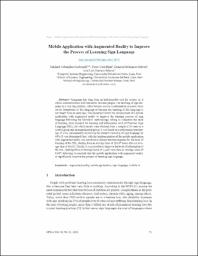| dc.contributor.author | Cabanillas-Carbonell, Michael | es_ES |
| dc.contributor.author | Cusi-Ruiz, Piero | es_ES |
| dc.contributor.author | Prudencio-Galvez, Daniela | es_ES |
| dc.contributor.author | Herrera Salazar, José Luis | es_ES |
| dc.date.accessioned | 2022-10-24T15:21:31Z | |
| dc.date.available | 2022-10-24T15:21:31Z | |
| dc.date.issued | 2022-06-07 | |
| dc.identifier.uri | https://hdl.handle.net/20.500.13053/6912 | |
| dc.description.abstract | Language for a long time is an indispensable tool for society, since it allows communication and interaction between people. Learning sign language is a very big problem, either because access to information is scarce, there are no interpreters of this language or because learning of this language is not taught from an early age. This document shows the development of a mobile application with augmented reality following the mobile methodology and determining the influence it has on the Peruvian sign language learning process, with a sample of 30 students as a control group and an experimental group. It started with a performance percentage of 23 percent and using the mobile application significantly improved the performance of the sign language student by 65 percent. | es_ES |
| dc.format | application/pdf | es_ES |
| dc.language.iso | eng | es_ES |
| dc.publisher | International Association of Online Engineering | es_ES |
| dc.rights | info:eu-repo/semantics/openAccess | es_ES |
| dc.rights.uri | https://creativecommons.org/licenses/by/4.0/ | es_ES |
| dc.subject | augmented reality, mobile application, sign language, mobile-d | es_ES |
| dc.title | Mobile Application with Augmented Reality to Improve the Process of Learning Sign Language | es_ES |
| dc.type | info:eu-repo/semantics/article | es_ES |
| dc.identifier.doi | https://doi.org/10.3991/ijim.v16i11.29717 | es_ES |
| dc.type.version | info:eu-repo/semantics/publishedVersion | es_ES |
| dc.publisher.country | DE | es_ES |
| dc.subject.ocde | http://purl.org/pe-repo/ocde/ford#1.02.02 | es_ES |


